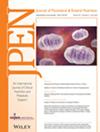Oxidative balance score and associations with dyslipidemia and mortality among US adults: A mortality follow-up study of a cross-sectional cohort
Abstract
Background
Oxidative stress has been implicated in the pathogenesis and progression of dyslipidemia. We aimed to investigate the association between the oxidative balance score, and dyslipidemia, as well as to assess the mortality risk associated with oxidative balance score in patients with dyslipidemia.
Methods
We performed a mortality follow-up study of a cross-sectional cohort of 26,118 adults from the National Health and Nutrition Examination Survey 1999–2018. The total oxidative balance score was calculated by 16 dietary nutrients (dietary oxidative balance score) and four lifestyle factors (lifestyle oxidative balance score). Weighted Cox proportional hazard model was applied to determine the relationship between oxidative balance score and all-cause or cardiovascular disease (CVD) mortality within the dyslipidemia group.
Results
During a median follow-up of 118 months, 2448 all-cause deaths (766 CVD-related) occurred. A significant negative correlation was observed between total oxidative balance score, dietary oxidative balance score, lifestyle oxidative balance score, and dyslipidemia. The multivariable-adjusted odds ratios and 95% CIs for dyslipidemia were 0.86 (0.77–0.97), 0.80 (0.72–0.91), and 0.63 (0.56–0.70), respectively, when comparing the second, third, and fourth quartiles of total oxidative balance score to the reference lowest quartile (P for trend <0.0001). Increasing total oxidative balance score was inversely associated with all-cause (hazard ratio [HR] = 0.98, 95% CI 0.98–0.99) and CVD-specific mortality (HR = 0.98, 95% CI 0.97–0.99) in participants with dyslipidemia.
Conclusions
Oxidative balance score is inversely associated with dyslipidemia and linked to all-cause and CVD-related mortality, highlighting the potentially protective role of an antioxidant-rich diet against dyslipidemia.


 求助内容:
求助内容: 应助结果提醒方式:
应助结果提醒方式:


